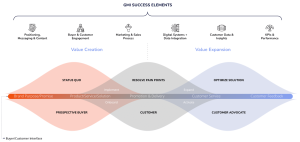Any leader worth their weight has taken a risk that failed, miserably. They’ve faced the inevitable, OMG…this is really happening to us right now. It may have been a bad business idea, or a questionable decision that led to undesirable outcomes or even an existential threat that is completely out of our control. Imagine being the executive team and board that is dealing with the Colonial Pipeline ransomware attack! The full impact of the attack still remains to be seen and they are definitely in the middle of a time that can easily feel like chaos.
So what do you do when there’s no way around it and the fall out is happening right now? You orchestrate the response. As leaders this is when we are called into duty and have an opportunity to shine. It’s what we’ve been training for and yet, it can feel just as daunting as it’s exciting. Because it’s literally hitting the fan, right now. This is when we must make clear decisions and not be swayed by our emotional responses to something we really wish wasn’t happening, but is. These are skills we don’t want to be learning on the job, but find ourselves often dealing with unexpected situations for the first time.
To be prepared we can practice skills that will help us when, not if, it does hit the fan so we can be proud of how we led by example. Here are 7 tips to find your calm when it all hits the fan and you’re dealing with the messy aftermath.
Find your center
There are going to be a lot of heightened emotional responses as people find themselves in panic mode. You can not be one of these people. You will need to find a way to find your center amidst the chaos so you can see the options in front of you clearly. To do this you’ll need to have practices that force you to drop back into yourself and create a barrier from the emotional chaos that is surrounding you. Remember, everyone looks to you to see how calm you are before they decide how much they should freak out. To do this, I simply take a deep breath, tune out the noise and drop my awareness into the center of my heart. It only takes a second and there is always a place of peace there that I can tap into and center myself around. Being able to feel the world around you without the chaos is critical to help your nervous system relax so you can develop the best response.
Find the threat
To respond, we need to understand what we are up against. We might not have all the answers right away, but we have some of them. Take an hour and allow yourself to chart out all of the worst case scenarios. Your mind simply needs to go here for you to be able to relax, so allow it. Make a list of all the potential outcomes and the threats that are creating those possibilities. Stack rank these threats based on their probability and potential impact and organize your thoughts around what this means for the business. Now you know what you need to address and what order to address them in, move to analyzing the threat. Look at the threat from every angle, turn it upside down, right side up and spend time understanding the potential impacts. Then look for where there are weaknesses that could exploit the company. And weaknesses that could be exploited to resolve the threat. Finally, ask your team for any additional threats that they see. You’ll have blind spots and you need outside input to help you avoid them.
Create a plan
Now, we understand the threat. It’s time to figure out the solution. First, consider the resources you have at your disposal. Who can help to create this action plan? Who will be responsible for executing the plan? What additional resources do we have available to execute the plan? This is the time to pull together your A-Team and let them in on what you’ve discovered so far and ask for their help in formulating a solution. You’ll need to have a plan that covers what needs to happen immediately and what needs to be done once you get out of the middle of the chaos and the situation starts to die down. Then you’ll need to identify the gaps you will need to fill. Where do you need outside help? Where can you tap into internal resources? Where do you need to roll up your sleeves? And who is leading who through all of this? When you’re in the middle of it, the entire Executive team needs to be able to come together and join the team in the response. So create a plan that considers what you could accomplish if all hands were on deck. This is a good time to ask the question “no BS, what would it really take?”
Create triggers for activation
The level of response will be indicative of the level of the threat and should include triggers for what happens when things get better and if they get worse. If the threat is impacting revenue, there is a potential you will lose part of your team or have to make significant budget changes. Where will you prioritize those changes? What triggers will need to happen before that part of the plan is activated? During the Pandemic, our executive team laid out a list of potential threats and triggers that would require us to make decisions like deferring bonuses and laying off staff. This allowed us to communicate those triggers early and allow employees to make the best decision for themselves and their families. We were fortunate to never have to put any of those plans in motion, but we had them and that gave us more peace of mind that we had done our due diligence. Do your due diligence here and consider what happens if revenue declines to a certain level or media coverage gets out of control or whatever outcome is so undesirable that got you here.
Execute the plan
Just execute the plan. It sounds simple, but how many times have you put together a good plan only to find that things get off track because someone had a new idea in the middle of execution that took things on a wild turn. As a leadership team, we have to hold our teams accountable to focusing on the objectives at hand and executing the plan. But we need to do it without creating an environment where employees don’t feel safe to speak up when the plan legitimately isn’t working. There is a balance to strike between listening to feedback and overcoming resistance to change. When people are in the midst of career chaos you may be surprised at how much resistance you get from people who are in a place of fear. They want the crisis to end, but can’t see their role in ending it. Your job is to make sure everyone knows their role, why their role is important and that this is a team effort. Remind them that every contribution counts and you can’t do it without everyone doing their part.
Measure the plan
A critical component of your response is to measure it so you know what is working and what isn’t. This is where the rubber meets the road. Look at your plan and ask yourself, “how will I measure whether or not this is working?” Sometimes this is easy as in the case of a threat that is impacting revenue. You know it’s working when you can stop the bleeding. But in the case of a public relations threat where your company’s brand is under scrutiny and you have to measure sentiment it can be more challenging. In any case, you will need a list of metrics that you will evaluate daily to determine whether or not the plan needs to be adjusted. These metrics should be communicated with the plan and everyone should be aware that they are the metrics they will be held accountable to. Finally, make the dashboard of these metrics transparent so everyone can see them. There’s nothing worse than secrecy in a time of crisis. Transparency is the key to keeping your team calm and committed to the response.
Modify the plan
There’s zero chance you’re going to get this right the first time or that circumstances aren’t going to change along the way. Your plan will need to be agile enough to allow for rapid shifts when you gather new information. To do this, you’ll need to embed a feedback loop so you know what is working and what isn’t. Your metrics will be your early indicators of success and failure. You want to know when to double down on something that’s working and when to pull the plug on something that isn’t. I ask, how long do I need to let this continue to know if it is working or not? I consider the amount of time it takes to get traction as well as when too much time has passed and the return isn’t aligning with the effort. Once I understand those two things, I can start to evaluate the plan for effectiveness and adjustment. As I review the metrics I simply ask, “what can I double down on?” and “what can I pull the plug on and redirect resources?” Then I act accordingly.
Understanding how to respond when it hits the fan is half of the battle. The response is simply the output of your decades of life experience being packaged together in a box. Whether that box is nice or not, is entirely up to you. During a time of crisis, I put my head down and focus on solving the problem. I’m relentless until there is a plan and potential solution in place. This is a natural part of leadership. The piece we can’t leave at the office. Because when it hits the fan, an entire company is depending on our ability to respond and make the right call. And that can start to feel heavy when you’re still in the middle of figuring it out. Trust that you will figure it out and take a moment to put on your oxygen mask so you can be clear headed and focused when you put together your plan of action. Then roll up your sleeves and get it done. You were born for this.
Business & Finance Articles on Business 2 Community
(49)
Report Post







